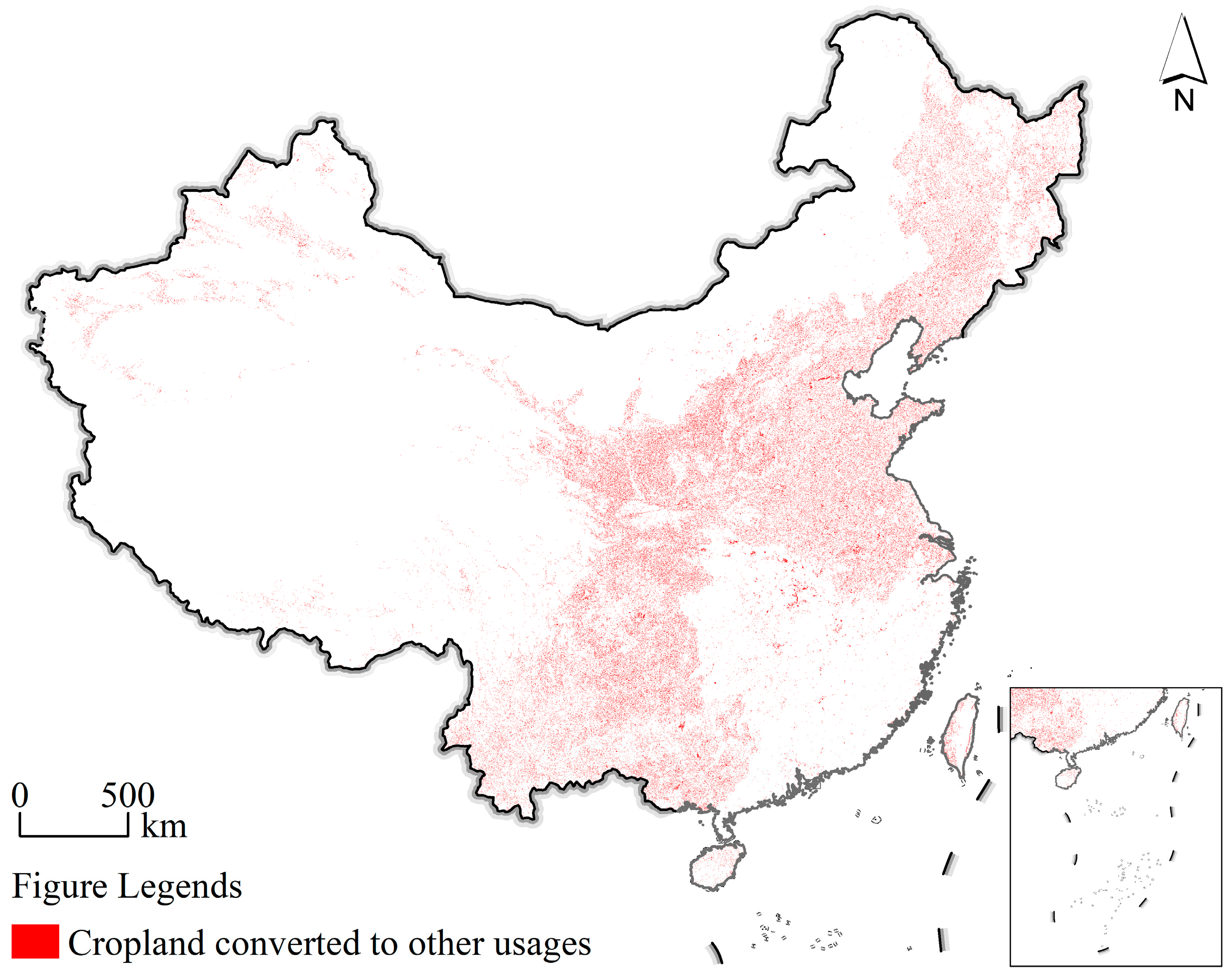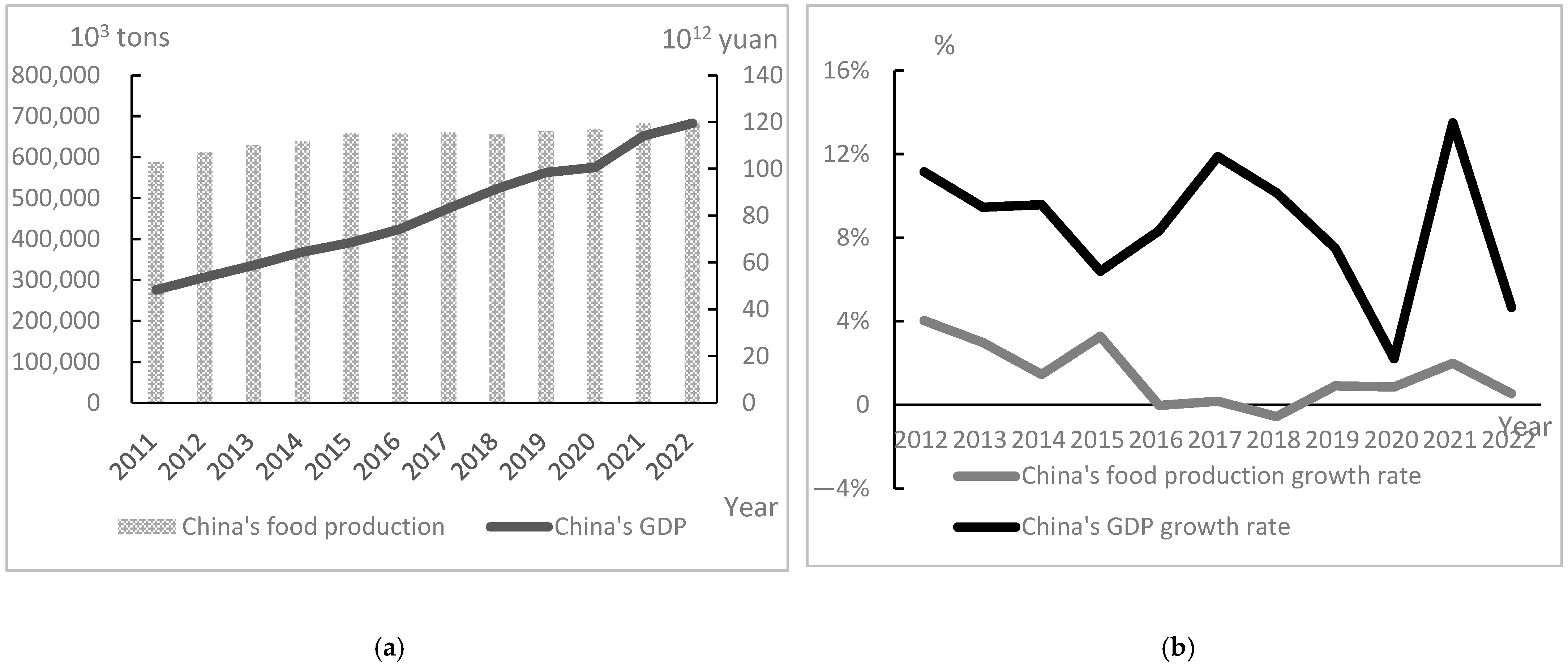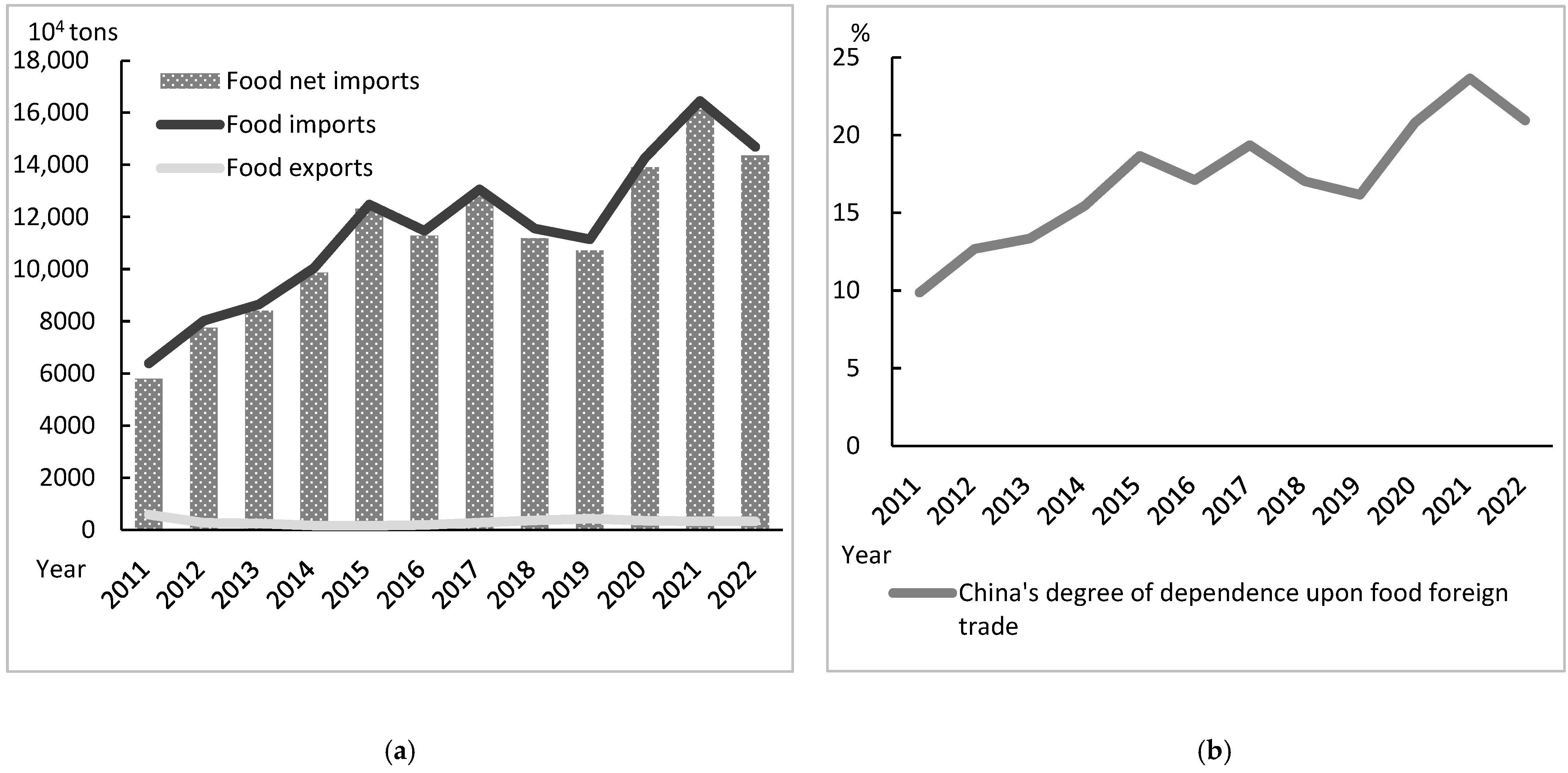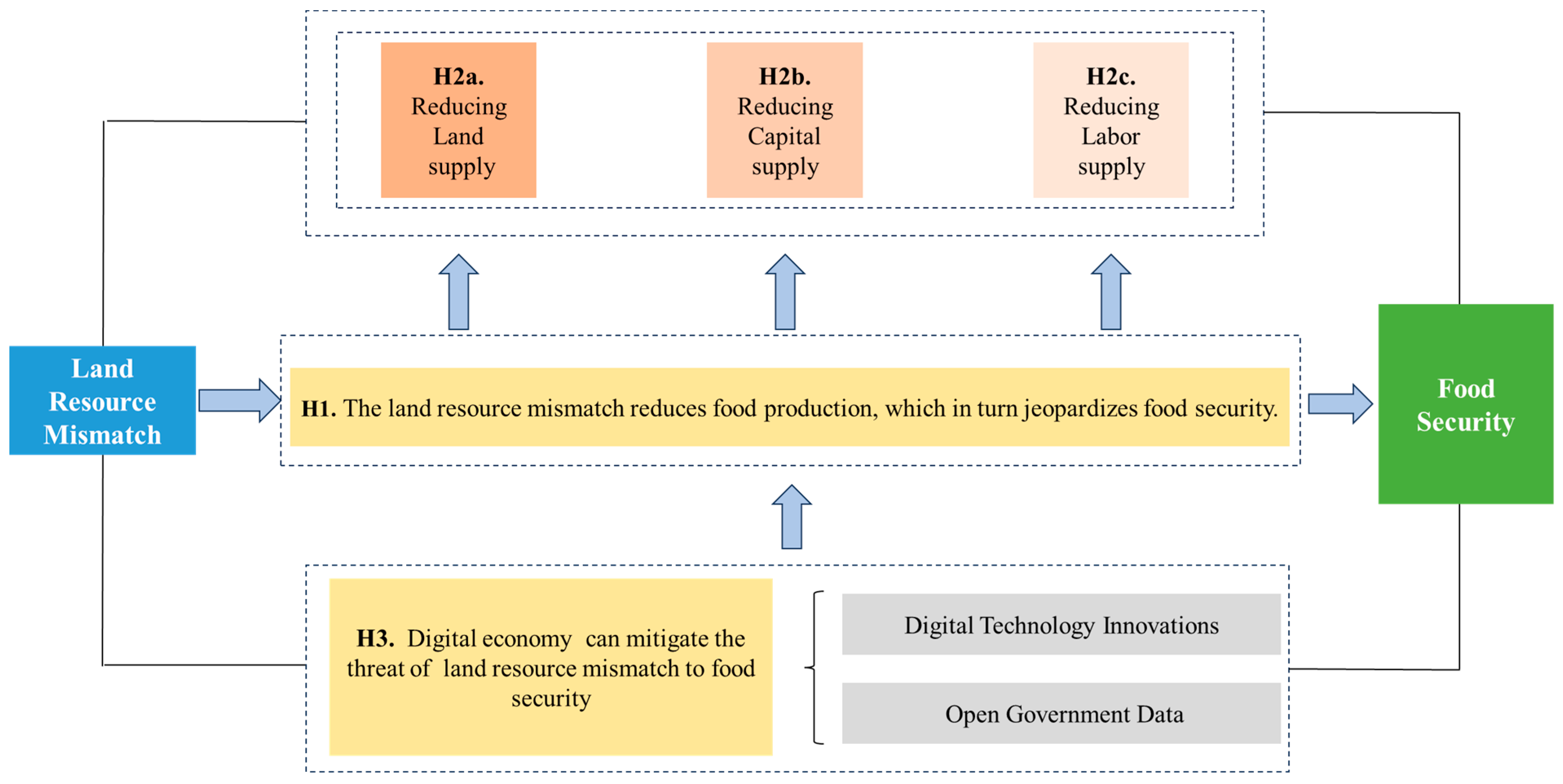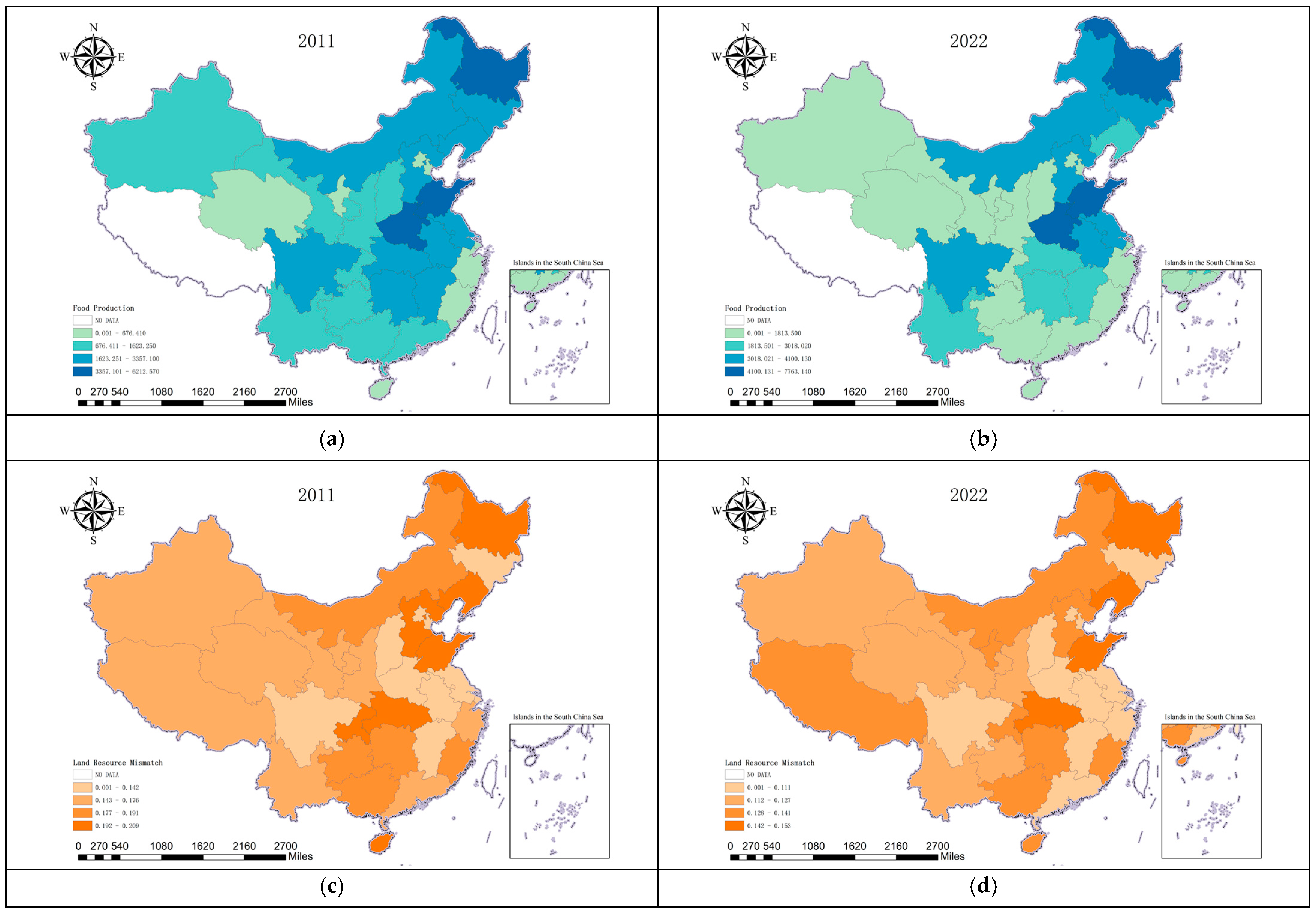1. Introduction
Food, as the most fundamental subsistence material for the populace, constitutes a crucial strategic material intimately tied to national livelihood and economic security, characterized by the discontinuity of its production process and the irreplaceable nature of its demand [
1]. The quantity and quality of arable land are two key factors affecting a country’s food production capacity. Therefore, ensuring its security has always been a significant concern, particularly for countries like China, where arable land resources are scarce and ecological and environmental issues are severe. Both of these factors are, in fact, impacted by land resource mismatch (LRM) [
2]. LRM refers to the phenomenon where local governments attract foreign investment by offering low industrial land prices and generous land supplies to cultivate the tax base and propel economic development. This often results in a significant conversion of agricultural land into construction land [
3], as illustrated in
Figure 1. Both domestic and international experience demonstrates that densely populated countries inevitably experience significant losses of arable land during the process of industrialization [
4]. Firstly, the growth in population, economic development, housing demands, industrial expansion, and infrastructure construction necessitate vast amounts of land for construction, inevitably encroaching upon arable land [
5,
6]. For instance, Japan’s arable land decreased by 52% between 1955 and 1994, while South Korea’s decreased by 46% from 1965 to 1994 [
7]. Similarly, according to the Statistical Yearbook of Urban Construction in China, China’s construction land has expropriated an average of 77,766.67 hectares of arable land annually over the past thirteen years. Secondly, the overall quality of land occupied for non-agricultural construction tends to be superior to that of the reclaimed wasteland used as compensation. Additionally, land scarcity often leads to overuse of arable land and excessive fertilizer application, resulting in a decline in the quality of arable land [
8]. In 2023, China’s food output reached 695 million tons, witnessing a continuous growth for 18 consecutive years. However, in the same year, China’s grain imports reached total of 160 million tons, making it the world’s largest importer of agricultural products. This suggests that China’s food supply is insufficient to achieve a high level of self-sufficiency. Against this backdrop, it is of utmost practical significance to delve deeply into the effective pathways for optimizing land resource allocation and food production and supply, thereby enhancing food security (FS) levels. The advent of the digital economy (DE) has revolutionized agricultural development, with digital technology and data factors continually expanding into rural areas and gradually infiltrating agricultural production, circulation, and other aspects. By integrating these factors, they empower and augment the efficiency of other production factors, achieving a synergistic effect where 1 + 1 > 2 and providing a more potent leadership and support framework for addressing FS challenges. Based on this premise, this study aims to explore the potential impact of the DE on the phenomenon of LRM, with the objective of identifying a pragmatic path to bolster FS capacity.
The important cause of LRM in China lies in the national situation of large numbers of people and small amounts of land, resulting in the fact that most of the available land has already been taken up by arable land, for example, so that land for construction needs to encroach on land with other uses. The direct cause can be traced back to changes in local government behavior as a result of the fiscal decentralization brought about by the tax system reform. Corporate income tax has become the main source of finance for local governments, leading to a keen supply of land for construction at the expense of land for other uses [
9]. Specifically, corporate income tax has emerged as the primary revenue source for local governments, prompting them to actively attract foreign investment by offering low industrial land prices and generous land supplies [
10]. Over the past two decades, the dedication of substantial quantities of premium arable land towards economic construction has objectively propelled China’s swift economic development, albeit resulting in a relative plateau in agricultural growth, as depicted in
Figure 2. During the initial phase of economic construction, spanning from 1992 to 2013, China’s average GDP growth rate stood at an impressive 16.28%. This rapid escalation in economic standing and residents’ incomes rendered the conversion of arable land for non-agricultural purposes feasible. Consequently, scholarly discourse concerning land resource allocation during this era predominantly centered on strategies to empower high-productivity enterprises to secure adequate factor inputs through effective land resource allocation, thereby ensuring an overall augmentation in economic productivity [
11]. Consideration of the value of the decolonization of arable land is also limited to the realm of economic value [
12]. When high-speed growth is no longer sustainable, the question of whether to continue to invest a large amount of high-quality arable land in industrial, mining, and storage construction becomes a questionable issue. During this period, the non-economic value of agricultural land was gradually emphasized, and the trade-off between economic and agricultural land became a hot topic. On the one hand, the ecological value of agricultural land has received more attention, such as its function of purifying air, preventing soil erosion, and regulating biodiversity [
13,
14]. On the other hand, the significance of arable land for guaranteeing FS is also recognized, and most of the existing studies show that both population growth and the income of the population place higher demands on the amount of arable land [
15]. However, there remains a lack of clarity regarding whether LRM impacts food production, specifically through channels such as decreased land and other essential factors and how to address the FS challenges stemming from such mismatches. This study endeavors to provide answers to these questions, offering a novel perspective on understanding the ramifications of LRM in China and presenting a fresh idea for local governments to mitigate this phenomenon.
In 1983, the World Food Organization (WFO) articulated that the objective of FS is “to guarantee that all individuals have access to sufficient and affordable basic foodstuffs at all times” [
16]. Consequently, the cornerstone of ensuring FS resides in the production and accessibility of food for an entire country’s populace. However, China’s dependence on foreign trade for food has risen over the years, from 10% in 2012 to around 20% in 2022, as shown in
Figure 3, which means that FS is not yet fully guaranteed in China. From the perspective of food demand, China’s population, although no longer growing, will remain stable at over 1.4 billion for an extended period. Furthermore, as China’s economy expands and the living standards of its citizens improve, the food consumption structure of the Chinese populace are evolving. Direct food consumption, or the demand for staple foods like rice and wheat, remains stable. However, indirect food demand, particularly for feed and industrial food products, is on a steady rise. This surge ultimately fuels China’s overall food demand, especially for protein-rich feed consumption. Consequently, the challenge of FS necessitates increasingly effective solutions. From the perspective of food supply, academics have observed that LRM can lead to mismatches in other production factors, such as labor and capital [
17,
18]. A critical issue that has garnered insufficient attention is the encroachment of farmland and arable land for higher economic gains due to LRM. This phenomenon raises concerns about whether the loss of production factors resulting from such mismatches could further exacerbate adverse impacts on China’s FS. It is imperative to address this question to ensure the sustainability and stability of China’s food supply. Secondly, the empowering role of the DE in agriculture is increasingly recognized in the academic literature as a crucial solution for FS. Studies have demonstrated that precision farming techniques, smart agricultural machinery, and efficient supply chain management facilitated by the DE have significantly enhanced agricultural productivity. These advancements not only improve the efficiency of farming operations but also optimize resource allocation, thereby contributing to increased food production and helping to safeguard FS [
19,
20,
21]. Given the slow growth in China’s arable land area and the lack of a significant improvement in land quality [
22], it is essential to explore whether the DE can mitigate the adverse effects of LRM. By leveraging the DE, we can harness its potential to better position the primary industry as a new growth engine. Addressing the challenges of low output efficiency, environmental constraints, and resource limitations within China’s agricultural industry is crucial. By achieving this, we can increase agricultural productivity and point the way toward ensuring China’s FS and facilitating the transformation of its agricultural sector. This approach offers a promising direction for sustainable agricultural development and FS in China.
As we enter the DE era, advancements in digital technology have transformed data into a pivotal resource. Data are now universally acknowledged for their substantial economic and social value [
23,
24], stemming from their characteristics of shareability, reproducibility, and infinite availability. These attributes have shattered the constraints previously posed by limited supplies of traditional production factors, such as land and capital, thereby facilitating economic growth. Simultaneously, the explosive growth in the scale of data has not only elevated their prominence in the development of the DE but has also significantly impacted the transformation of traditional production modes [
25]. This surge has led to the emergence of new industries, business models, and operational methods, solidifying data’s role as a crucial production factor driving economic and social development [
26]. According to the Internet Development Report 2022, the scale of China’s DE industry is stable and good, realizing RMB 50.2 trillion of industrial output value, of which rural online retail sales contribute to RMB 2.05 trillion of innovative revenue growth, an increase of 11.3% year-on-year, which is a good result of the deep integration of the agricultural economy and the DE. In this context, data and digital technology function as the means of production and labor tools for the advancement of the DE. By optimizing resource allocation and enhancing production efficiency, it mitigates the excessive consumption of agricultural resources [
27]. For instance, through the utilization of digital agricultural management systems [
28], farmers can monitor real-time data such as soil moisture and weather conditions. This enables them to achieve precise fertilization and intelligent irrigation, thereby substantially enhancing the utilization efficiency of farmland. Obviously, the DE can effectively bolster the total factor productivity of agriculture by optimizing the allocation of production factors [
29], thereby creating a new growth pole for the agricultural economy [
30,
31]. Consequently, it is crucial to explore whether the DE can address the challenges posed by the LRM for FS. While scholars have already identified that the development of the DE significantly contributes to FS in China, exhibiting a dampening effect on localized FS and a facilitating effect on neighboring areas’ FS [
32], the crucial material basis for food production, namely arable land, has not been thoroughly discussed. Therefore, from the perspective of the DE, optimizing the allocation of land resources through digital technology and data factors in order to ensure the security of food production still remains an important topic that needs to be explored and practiced in depth.
Based on this, this study delves into the adverse effects of LRM on FS using China’s provincial panel data spanning from 2011 to 2022. Firstly, it is revealed that LRM can decrease food production and pose a threat to FS, a finding that remains significant even after conducting a series of robustness tests. Secondly, this study examines the specific mechanisms through which LRM adversely impacts FS, including the reduction in the supply of land, labor, and capital factors essential for food production. Finally, this study proposes practical recommendations to mitigate these negative impacts, namely leveraging the technology and data factors introduced by digital technology and open data to alleviate the threat posed by LRM to FS.
The research contributions of this study are as follows: Firstly, this study enhances the existing literature on FS. Typically, FS is examined from the perspectives of arable land area, fertilizer application, and mechanical inputs [
33,
34,
35]. However, the FS issues stemming from the economic and social values underlying LRM have been overlooked by academic circles. This study aims to contribute to the literature by highlighting the negative impacts of LRM on FS. This not only diversifies the academic research on the factors influencing FS but also furnishes policymakers with scientific evidence on optimizing land resource allocation, conserving arable land resources, and safeguarding FS. Second, this study enriches the literature on the consequences of LRM. Existing research on the negative impacts of LRM has shifted from purely economic value comparison to sustainable development perspectives such as ecological value [
36,
37], but the impacts on FS and its specific channels of action have not yet been subjected to rigorous theoretical and empirical tests. This study explores the impact of LRM on FS and also constructs a multidimensional analytical framework for FS from the perspectives of factors of production such as capital, labor, and technology, which can not only help academics to further develop related research but also provides policymakers with more comprehensive and systematic policy references. Thirdly, this study engages in a discussion on the heterogeneous effects of LRM on FS, revealing that factors such as urbanization, the tenure length of officials, and the role of primary food-producing regions can all exert different impacts on FS. By analyzing regional heterogeneity, this study assists policymakers in crafting more precise regional development strategies, optimizing the layout of food production, and enhancing the national level of FS. Furthermore, it offers policymakers a more intuitive and specific anticipation of policy outcomes, which can aid in guiding policy formulation and adjustment. Lastly, this study explores the moderating role of the DE in alleviating the adverse effects of LRM on FS. Unlike much of the existing literature that treats the DE as an explanatory variable and examines its impact on food production and resilience [
38,
39], this study delves into how digital technology and data factors can facilitate food production development through various channels by incorporating moderating variables such as digital technology and open government data. This study not only broadens the research scope concerning the effectiveness of the DE but also presents policymakers with novel ideas for leveraging the DE to propel agricultural modernization.
The research layout of this study is as follows: the second part is the theoretical derivation; the third part is the research design, including the data source, model design, and variable definition; the fourth part is the empirical analysis, including a descriptive test and a basic regression and robustness test with heterogeneity analysis; the fifth part is a further analysis, including a mechanism test and moderating effect analysis; and the sixth part is the conclusion and recommendations.
2. Theoretical Analysis and Research Hypothesis
The rapid expansion of urbanization has created a tremendous demand for land resources. As populations have become increasingly concentrated in urban centers, the need for residential, commercial, and industrial land has surged significantly [
40]. This has led to substantial amounts of farmland being repurposed for non-agricultural use. However, these transitions are not always driven by optimal market-based allocations but are frequently influenced by government intervention, which accelerates the conversion of land to non-agricultural purposes. Local governments, motivated by fiscal revenue as a performance indicator, often suppress industrial land prices and increase the availability of construction land, resulting in vast swaths of farmland being transformed into industrial or construction land [
41]. This behavior distorts the land market’s pricing mechanism, creating a mismatch between agricultural and construction land, which, in turn, causes a considerable loss of arable land and weakens grain production capacity [
42]. Consequently, the land resources essential for agricultural production are inadequately safeguarded, directly impacting grain yields and threatening national FS.
Moreover, from the standpoint of externality theory, the inefficient allocation of land resources generates substantial negative externalities [
43]. In the course of urbanization, the loss of arable land diminishes the total area available for grain production. For a populous country like China, where arable land is relatively scarce, this represents a serious threat to FS. LRM, by reducing the amount of arable land, leads to decreased grain production, which can result in food supply shortages, price volatility, and a series of chain reactions that ultimately jeopardize national FS. Based on the above, this study proposes the following hypothesis:
H1. LRM reduces food production, which in turn jeopardizes FS.
Grain production is, in essence, a complex process involving the input and output of multiple factors. This study uses a production function, where the output is denoted by Y, and the five key production factors, capital, labor, technology, and data, are represented as , , , , and , respectively. This model helps to reveal how changes in these production factors influence grain output.
From the perspective of land resources (
), land is an essential factor in agricultural production. LRM directly reduces the amount of land available for grain production [
43,
44]. In the context of rapid urbanization, a significant portion of high-quality arable land has been converted into industrial and urban construction land, resulting in an insufficient supply of agricultural land. This mismatch not only decreases the total area of arable land but also creates an imbalance in land use, reducing the overall productivity of the land. Furthermore, the shrinking supply of arable land may limit both the scale and variety of crops that can be cultivated [
45]. In regions where land resources are scarce and the quality of arable land is generally low, this mismatch further exacerbates constraints on food production, posing a serious threat to FS.
From the perspective of capital (
), LRM results in insufficient capital investment in agricultural production. Local governments tend to allocate land resources for industrial development, diverting capital that could have been used to enhance agricultural productivity, improve agricultural infrastructure, and promote agricultural technology to more profitable industrial sectors [
46]. This lack of investment reduces the profitability and enthusiasm of farmers [
46], restricting agricultural technological progress and capital accumulation. As a result, grain production struggles to achieve economies of scale or intensive growth, hindering increases in grain output.
From the perspective of labor (
), the flow of labor is also impacted by LRM. As urbanization accelerates, a large number of young rural workers migrate to cities in search of higher incomes and better living conditions [
47]. This trend reduces both the quantity and quality of labor engaged in grain production, resulting in an aging workforce [
48] and a decline in labor skills. These factors hinder the refined management of agricultural production and the adoption of new technologies, exacerbating the challenges in agricultural production and limiting the total grain supply.
In summary, LRM negatively affects the material base and production capacity of food production by reducing the supply of land, capital, and labor factors, thus endangering the stability of national FS. Therefore, this study proposes the following hypothesis:
H2a. LRM reduces the availability of land factor for food production, which, in turn, jeopardizes FS.
H2b. LRM reduces the availability of capital factors for food production, which, in turn, jeopardizes FS.
H2c. LRM reduces the supply of labor factor for food production, which, in turn, jeopardizes FS.
With the rapid development of digital information technologies and the aggregation of vast amounts of data, “digitalization” has become the prevailing trend [
49]. Emerging digital technologies, such as big data, cloud computing, and the Internet of Things, are increasingly penetrating various sectors, reshaping existing production models [
50]. The DE enables the digital transformation of traditional agriculture through data and digital technologies. Based on the productivity theory of Marx, the revolutionary breakthrough of technology and the innovative allocation of production factors, namely, the labor force, labor means and labor objects and their optimal combination help to promote the improvement in productivity. Following this theory, the deep integration of data and technology with traditional production factors can not only transform agricultural production methods but also enhance overall productivity.
From the perspective of digital technologies (T), large-scale farming has gradually emerged as the dominant trend in agricultural development within the current context of rural land transfers. Expanding production scales allows farmers and agricultural companies to utilize large machinery and digital technologies for operations, thereby liberating labor [
51]. Digital technologies can transcend the limitations of resource scarcity and the obsolescence of traditional agricultural practices [
52]. By transforming the business models and operational concepts of modern agricultural enterprises through information technologies, digital solutions can enhance the efficiency of labor and material resources, ultimately improving agricultural productivity [
53] and the quality of grain production. For instance, smart agricultural equipment can monitor crop growth throughout the production process and assist in adjusting factors such as light, water, temperature, and soil quality, thereby mitigating the adverse effects of natural variables and ensuring stable crop yields. This fosters the standardization and scaling of agricultural production, alleviating the constraints of resource scarcity.
From the perspective of data (D), data exhibit characteristics of non-competitiveness and non-exclusivity, thereby overcoming the constraints imposed by the limited supply of traditional production factors [
54] and further enhancing productivity levels. Although data have always existed in traditional agriculture, they have often been fragmented and granular, lacking continuity and completeness, which limits their inherent value. In the digital era, these data can now be collected, classified, cleaned, aggregated, and shared through open government data platforms, facilitating widespread application by various stakeholders. For example, on the open government data platforms, there is basic situation information of rural areas under the theme of “agriculture and rural areas”, including the total output value of agriculture, forestry, animal husbandry and fisheries, the production and operation information of agricultural products, etc., tax information, penalty data, and consumption data under the theme of “credit service” and “fiscal and taxation finance”. Based on these open government data, first of all, they help agricultural operators to obtain richer decision-making information, including information on agricultural resources, supply and demand in the agricultural market, and policy information on industrial development, thus helping them to make scientific choices in their decision-making. Furthermore, LRM is often accompanied by insufficient capital investment in agriculture. However, open government data sharing can help alleviate the information asymmetry between banks and enterprises [
55], enabling banks to more accurately assess the creditworthiness and production potential of agricultural companies. This increases credit support for agricultural enterprises, facilitating adequate capital investment, expanding production scales, and enhancing total factor productivity, thereby ensuring the sustainability of agricultural production and FS.
Based on the above analysis, this study proposes the following hypothesis:
H3a. Digital technology innovations can mitigate the threat of LRM to FS.
H3b. Open government data can mitigate the threat of LRM to FS.
The theoretical mechanism diagram of this study is shown in
Figure 4.
6. Conclusions and Suggestions
6.1. Research Conclusions
This study uses provincial panel data from China spanning from 2011 to 2022 to investigate the negative impact of LRM on FS, examine the impact mechanisms, and highlight the crucial role of the DE in alleviating these negative outcomes. First, the findings reveal that LRM significantly reduces grain production, posing a threat to FS. This conclusion remains robust after a series of robustness checks. Second, this study discusses the heterogeneous effects of LRM on FS, showing that regions with higher urbanization levels, shorter official tenures, and that are non-major grain-producing areas experience a more pronounced negative impact on FS. Lastly, this study explores how LRM impairs FS and offers potential solutions. By diminishing the supply of essential factors such as land, labor, and capital for grain production, LRM undermines the material foundation and productive capacity of the sector. The DE, by providing technological and data resources through digital innovation and open government data, helps mitigate the threat posed by LRM to FS.
6.2. Policy Recommendations
In order to address LRM, policy guidance should be enhanced, and institutions should be optimized. First, land market reforms should be promoted by establishing a comprehensive land market system and improving transaction rules to ensure the efficient allocation of land resources through market mechanisms. Second, the fiscal tax-sharing system should be reformed to reduce local government dependence on land-based financing. This can be achieved by moderately adjusting the system to discourage the transfer of large amounts of arable land for short-term fiscal gain. A diversified local revenue system should be established, with an emphasis on increasing tax revenue sharing and transfer payments to alleviate fiscal pressures on local governments. Finally, a mechanism linking the tenure of officials to the food security accountability system should be established. Considering that the short tenure of officials may exacerbate short-term behaviors in land resource management, it is recommended that food security be incorporated into the performance appraisal system of local officials, especially for non-major food-producing areas and sensitive areas of land resource management, to implement a stricter food security accountability system and to encourage officials to adopt, during their term of office, land policies that are conducive to the long-term development of food production.
The construction of high-standard farmland should be promoted, and farmland protection should be strengthened. First, investment in high-standard farmland should be increased to boost both production capacity and output efficiency. Land consolidation and agricultural water conservancy projects should be implemented to improve infrastructure and enhance land use efficiency. Second, farmland management systems should be improved with strict land use controls, setting clear boundaries for arable land and ecological protection zones to prevent illegal occupation of high-quality farmland. A robust compensation system for farmland occupation should be established to ensure that any land taken for construction is replaced by land of equal or superior quality. Finally, stringent farmland protection policies should be enforced, farmland quality should be regularly monitored, and damaged farmland should be promptly restored. Illegal activities that harm the quality of farmland should be punished.
Rural employment conditions should be improved, and the supply of labor factors should be increased. First, rural infrastructure can be enhanced by improving roads, water supply, electricity, telecommunications, and other facilities to make rural living more convenient and attractive for labor retention. Second, rural vocational education should be invested in to build a multi-tiered training system that improves the skills and competence of the rural workforce. Various training programs should be provided to help farmers master modern agricultural techniques, thereby increasing productivity and market competitiveness. Finally, young people should be encouraged to return to rural areas by offering policy support and financial incentives for entrepreneurship in modern agriculture and processing industries.
External investment should be attracted to increase agricultural capital supply. First, agricultural investment should be increased through both direct fiscal support and policy-based financial assistance. Government subsidies and funding for agricultural infrastructure should be expanded to boost capital investment in agriculture directly. Financial services such as low-interest loans and credit guarantees should be offered to lower financing costs and encourage further investment in agricultural production. Second, the development of agricultural insurance should be promoted to protect against risks from natural disasters and market fluctuations. The coverage of agricultural insurance should be expanded to ensure more farmers benefit from this financial protection, and additional social capital should be attracted into the agricultural sector to strengthen overall capital supply.
Open government data should be leveraged to improve land resource allocation efficiency and grain production. The government should lead the creation of a comprehensive, authoritative, and user-friendly open government data platform that consolidates information from the agriculture, land, meteorology, and market sectors. Clear standards and access protocols should be established to ensure that key agricultural and land resource data are made available in a timely and accurate manner. Enterprises, research institutions, and individuals should be encouraged to utilize open data to develop intelligent agricultural solutions, such as precision fertilization, smart irrigation, and pest forecasting. Financial institutions should also use these data to better assess the creditworthiness of agricultural operators, promoting innovative financing models like supply chain finance and agricultural insurance linked to futures markets.
Digital technology must be actively utilized to improve agricultural productivity and quality, ensuring national FS. First, investment in rural digital infrastructure should be increased, and internet access should be expanded to ensure farmers and agricultural businesses can easily access digital resources. Agricultural big data centers should be built to gather and analyze information on production, markets, and resources, providing scientific support for agricultural decision-making. Second, developing and using intelligent agricultural machinery, such as autonomous tractors, drones, and smart seeders, should be promoted to enhance production efficiency. The Internet of Things (IoT) technology should also be employed to monitor soil conditions and crop growth in real time, providing precise production guidance. Finally, digital management capabilities in agriculture can be strengthened by creating integrated platforms for managing production, markets, and resources. Farmers and agricultural employees should be trained in digital skills to ensure they can fully utilize new technologies in their work.
